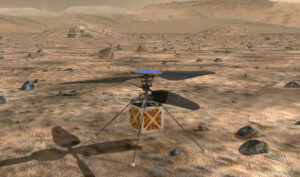AHS International — The Vertical Flight Society — applauds the recent announcement by the U.S. National Aeronautics and Space Administration (NASA) that it will develop a small unmanned helicopter to explore the surface of Mars. NASA announced its plans on May 11, 2018 to launch the Mars Helicopter.

NASA describes the origins of the project: “Started in August 2013 as a technology development project at NASA’s Jet Propulsion Laboratory (JPL), the Mars Helicopter had to prove that big things could come in small packages. The result of the team’s four years of design, testing and redesign weighs in at little under four pounds (1.8 kilograms). Its fuselage is about the size of a softball, and its twin, counter-rotating blades will bite into the thin Martian atmosphere at almost 3,000 rpm – about 10 times the rate of a helicopter on Earth.”
However, the Mars Helicopter conceptual design was actually first conceived in 1999 in response to the American Helicopter Society International’s 17th Annual Student Design Competition. The winners of the graduate competition, announced in August 2000, were the Georgia Institute of Technology and the University of Maryland.
The UMD proposal, the Martian Autonomous Rotary-Wing Vehicle (MARV), was designed by a team led by Anubhav Datta, now an associate professor at Maryland.
The 1999-2000 AHS competition, sponsored by Sikorsky Aircraft and supported by NASA, was “to develop an autonomous rotorcraft for exploration of Mars. The mission was to be a proof-of-concept demonstration for rotary-wing flight in the Martian atmosphere.”
The similarities between the 2000 AHS-UMD MARV and the 2018 NASA Mars Helicopter, both with two-bladed coaxial rotors on a square fuselage, are quite noticeable.
Prof. Datta today recalls that the AHS Student Design Competition “generated the first serious detailed designs” of an aircraft capable of vertical flight in the thin atmosphere of Mars. While working as a researcher at the Ames Research Center (2007-2015), Datta also worked on the NASA Mars Helicopter development (2015-2017). “I certainly credit my expertise on Mars and my involvement in this project to that design.”
The 113-page University of Maryland proposal that won the 2000 AHS Student Design Competition is still available on the website. While there are many similarities, the sizes are quite different: the real Mars Helicopter is four pounds (1.8 kilograms), much smaller than the 50 kilograms that UMD designed nearly 20 years ago, and the hubs are hingeless not teetering. [A synopsis of the Maryland AHS report was later published in the Journal of Aircraft, v30, (3), 2003.]

Over the years, NASA has made several presentations at AHS events in support of the Mars Helicopter concept, including:
- “Design Opportunities and Challenges in the Development of Vertical Lift Planetary Aerial Vehicles,” Young, L.A., et al, Presented at the AHS Vertical Lift Aircraft Design Conference, San Francisco, California, January 2000.
- “Vertical Lift — Not Just For Terrestrial Flight,” Young, L.A., Presented at the AHS/AIAA/SAE/RAeS International Powered Lift Conference, Arlington, Virginia, Oct. 30 to Nov. 1, 2000.
- “Experimental Investigation and Demonstration of Rotary-Wing Technologies for Flight in the Atmosphere of Mars,” Young, L. A.; Aiken, E. W.; Derby, M. R.; Demblewski, R.; Navarrete, J., Presented at the 58th Annual Forum of the AHS International, Montreal, Quebec, June 11 to 13, 2002.
- “Engineering Studies into Vertical Lift Planetary Aerial Vehicles,” Larry A. Young, Edwin W. Aiken, et al, Presented at the AHS International Meeting on Advanced Rotorcraft Technology and Life Saving Activities, Utsunomiya, Tochigi, Japan, Nov. 11 to 13, 2002.
- “Generation of Mars Helicopter Rotor Model for Comprehensive Analyses,” Witold J. F. Koning, Wayne Johnson and Brian G. Allan, Presented at the AHS Specialists’ Conference on Aeromechanics Design for Transformative Vertical Flight, San Francisco, California, Jan. 16 to 18, 2018.
- “Vacuum Chamber Testing of 1.5 Foot Diameter Mars Rotor,” Daniel Escobar, Inderjit Chopra, Anubhav Datta, Presented at the AHS Technical Conference on Aeromechanics Design for Transformative Vertical Flight, San Francisco, California, Jan. 16 to 19, 2018.
The Vertical Flight Society’s Student Design Competition continues today, with final proposals due on May 31, 2018, for the 35th Annual Student Design Competition: “A Reconfigurable VTOL Aircraft,” sponsored by the U.S. Army Research Laboratory.
This week, the Vertical Flight Society is holding its 74th Annual Forum & Technology Display in Phoenix, Arizona, May 14 to 17. The graduate and undergraduate winners of the 34th Annual Student Competition for a “24 Hour Hovering Machine Conceptual Design” — both University of Maryland teams — will present their concepts on Tuesday, May 15, beginning at 11 a.m. at the Phoenix Convention Center.
This year, the Vertical Flight Society celebrates its 75th anniversary. It was incorporated as the “American Helicopter Society” (AHS) on June 25, 1943, by the early pioneers of the helicopter industry to advance vertical flight through technical collaboration and knowledge sharing.
The society has a proud legacy of successfully advocacy for advanced VTOL research and development for civil and military applications, as well as inspiring the next generation of helicopter and VTOL engineers through a wide range of student programs, including scholarships, design competitions and other leadership and technical opportunities.









